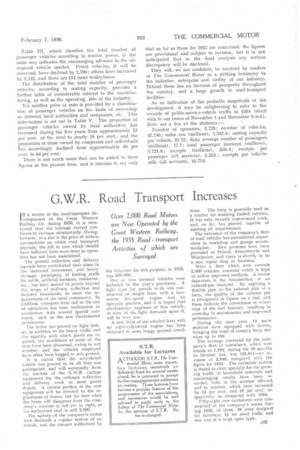G.W.R. Road Transport Increases
Page 91

If you've noticed an error in this article please click here to report it so we can fix it.
I N a review of the road-transport de velopments of the Great Western Railway Co. during 1935, it is mentioned that the tonnage carried continues to increase substantially. Owing, however, to a rise in the price of certain commodities on which road transport depends, the fall in cost which should have followed from econcmies in operation has not been maintained,
The general collection and delivery so:vices have contributed then share in the increased movement, and 'heavy tonnage, principally of feeding stuffs for cattle, artificial manures, roadstone, etc., has been moved to points beyond the scope of ordinary collection and delivery boundaries, to meet the requirements of the rural community. In addition, transport from rail to the site of operations has been undertaken in connection with several special contracts, such as the new Government aerodromes.
The la tter has proved no light task, as, in addition to the heavy traffic and the rapidity with which goods are reqiiired, the conditions at some of the Sites have been abnormal, owing to wet weather, and the vehicles employed have often been bogged in soft ground.
It is stated tbat the articulated vehicle has proved to be all that was anticipated, and will eventually form the nucleus of the G.W.R. cartage equipment for the ordinary collection and delivery work at most goods depots. A certain portion of the new equipment will be devoted to the replacement oi horses, but the time when the horse will disappear from the company's stations is not yet in sight, as the authorized stud is still 2,000.
The upkeep of the company's motor fleet demands a regular system of renewals, and the amount authorized by the directors for this purpose, in 1935, was £60,000.
One or two unusual vehicles were included in the year's purchases. A light type for parcels wcrk was constructed on simple lines, with a twostroke low-speed engine and an epicyclic gearbox, and it is hoped that maintenance expenses of this vehicle, in view of the light demands upon it, will be very low.
A new form of six-wheeled lorry with an eight-cylindered engine has been obtained to meet boggy ground condi lions. The lorry is generally used as a tractor for assisting loaded vehicles. It has only recently commenced work, and, so far, has proved capable of meeting all requirements.
The extension of the company's fleet of road vehicles has necessitated expansions in workshop and garage accommodation. New premises have been provided at Bristol, Aberystwyth and Winchester, and there is shortly to be a new repair shop at Swansea.
With a fleet which now exceeds 2,000 vehicles, constant watch is kept to utilize improved methods. A recent departure is the introduction of an exhaust-gas analyser. By applying a flexible pipe to the exhaust pipe ot a lorry, the quality, of the exhaust gas is interpreted in figures on a dial, and these indicate the correctness or otherwise of the fuel mixture, resulting in economy in maintenance and improved performance.
During the past Year, 10 more stations were equipped with lorries, bringing the total of country lorry services up to 166.
The tonnage conveyed by the company's fleet of containers, which now stands at 1,702, during the 10 months to October last, was 105,911—an increase of 2,040, compared with the figure for 1934. The container system is stated to cater specially for the growing traffic in household removals and encouraging results have been recorded, both in the number effected and in revenue, which have increased by 13 per cent. and 22 per cent. respectively, as compared with 1934.
Fifty-eight new containers were constructed at the company's works during 1935; of thete, 36 were designed for furniture, 21 for meat traffic and one was of a large open type.




































































































































































